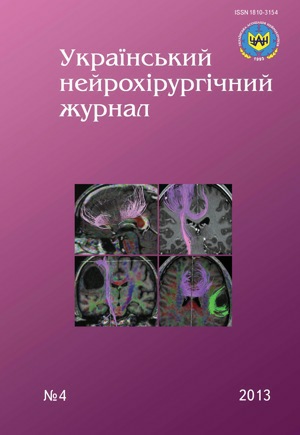The effectiveness of intraoperative hypothermia at microsurgery of brain aneurysms
DOI:
https://doi.org/10.25305/unj.55415Keywords:
subarachnoid hemorrhage, intraoperative preventive hypothermiaAbstract
The purpose: to determine effectiveness of prophylactic systemic hypothermia at surgical treatment of patients with brain arterial aneurysms in the early deferred period of subarachnoid hemorrhage.
Materials and methods. 105 patients with aneurysmal subarachnoid hemorrhage were examined. Aneurysm clipping was performed in all patients in the period of arterial spasm regression. The patients were divided into two groups: in 51 of them standard anesthetic management was used, in 54 — surgery was performed under systemic hypothermia. The influence of the patient’s body temperature during surgery on it’s outcomes was estimated.
Results. Only intraoperative aneurysm rupture (t=0,41, p<0,001) influenced significantly on results of treatment, there was no correlation with the body’s temperature (t=0,06, p=0,656). At normothermia temporary arteries clipping worsened the outcomes (t=0,50, p<0,001), while at hypothermia it practically didn’t effect them (t=0,21, p=0,023). Bradycardia, arrhythmia, hyperglycemia, hypokalemia were considered specific complications of hypothermia.
Conclusions. The patient’s body temperature at intraoperative bleeding does not affect the results of treatment; temporary clipping of cerebral arteries is most safe at hypothermia using; hypothermia application is possible at planning of arteries temporary clipping and at high risk of aneurysm re-rupture; the use of hypothermia effects positively the overall results of patients’ treatment in the early delayed period of subarachnoid hemorrhage.References
1. Connolly ES Jr, Rabinstein AA, Carhuapoma JR, Derdeyn CP, Dion J, Higashida RT, Hoh BL, Kirkness CJ, Naidech AM, Ogilvy CS, Patel AB, Thompson BG, Vespa P; American Heart Association Stroke Council; Council on Cardiovascular Radiology and Intervention;Council on Cardiovascular Nursing; Council on Cardiovascular Surgery and Anesthesia; Council on Clinical Cardiology. Guidelines for the management of aneurysmal subarachnoid hemorrhage: a guideline for healthcare professionals from the American Heart Association/American Stroke Association. Stroke. 2012 Jun;43(6):1711-37. [CrossRef] [PubMed]
2. Steiner T, Juvela S, Unterberg A, Jung C. European Stroke Organization Guidelines for the Management of Intracranial Aneurysms and Subarachnoid Haemorrhage. Cerebrovasc Dis. 2013;35(2):93-112. [CrossRef] [PubMed]
3. Krylov VV, Godkov IM, Genov PG. Intraoperatsionnyye faktory riska v khirurgii tserebral'nykh anevrizm [Intraoperative risk factors in surgery of cerebral aneurysms]. Neyrokhirurgiya. 2009;2:24-33. Russian. http://therjn.com/ru-ru/Files/Pdf/2009/2/24.pdf.
4. Li Bassi G. Perioperative hypothermia: the delicate balance between heat gain and heat loss. Comparison of forced-air warming and resistive heating. Minerva Anestesiol. 2008 Dec;74(12):683-5. [PubMed]
5. Ryogo A, Hideki S, Koji I, Izumi N. Effectiveness of brain hypothermia treatment in patients with severe subarachnoid hemorrhage - comparisons at a single facility Ryogo. Neurol. Medico-chirurg. 2010;50(10):879-83. [CrossRef]
6. Tцrцk E, Klopotowski M, Trabold R, Thal SC, Plesnila N, Schцller K. Mild hypothermia (33 degrees C) reduces intracranial hypertension and improves functional outcome after subarachnoid hemorrhage in rats. Neurosurgery. 2009;65(2):352-9. [CrossRef]
7. Sheng SP, Lei B, James ML, Lascola CD, Venkatraman TN, Jung JY, Maze M, Franks NP, Pearlstein RD, Sheng H, Warner DS. Xenon neuroprotection in experimental stroke: interactions with hypothermia and intracerebral hemorrhage. Anesthesiology. 2012 Dec;117(6):1262-75. [CrossRef] [PubMed]
8. Krylov VV, Tkachev VV, Dobrovol'skiy GF. Mikrokhirurgiya anevrizm Villiziyeva mnogougol'nika [Microsurgery aneurysms of Willis polygon]. Moscow: Antilor; 2004. Russian.
9. Gal R, Smrcka M. Mild hypothermia for intracranial aneurysm surgery. Bratisl Lek Listy. 2008;109(2):66-70. [PubMed]
10. Dudukina SO, inventor; Dudukina SO, assignee. A method of preventing complications of hypothermia. Ukraine Patent 74975A. 2012 November 12.
11. Dudukina SO, inventor; Dudukina SO, assignee. The method of correcting hyperglycemia in conditions of hypothermia. Ukraine Patent 74944A. 2012 November 12.
Downloads
Published
How to Cite
Issue
Section
License
Copyright (c) 2013 Svitlana Dudukina, Mykola Zorin, Sergiy Grygoruk, Illya Plyushchev

This work is licensed under a Creative Commons Attribution 4.0 International License.
Ukrainian Neurosurgical Journal abides by the CREATIVE COMMONS copyright rights and permissions for open access journals.
Authors, who are published in this Journal, agree to the following conditions:
1. The authors reserve the right to authorship of the work and pass the first publication right of this work to the Journal under the terms of Creative Commons Attribution License, which allows others to freely distribute the published research with the obligatory reference to the authors of the original work and the first publication of the work in this Journal.
2. The authors have the right to conclude separate supplement agreements that relate to non-exclusive work distribution in the form of which it has been published by the Journal (for example, to upload the work to the online storage of the Journal or publish it as part of a monograph), provided that the reference to the first publication of the work in this Journal is included.









